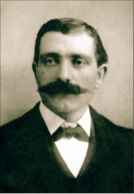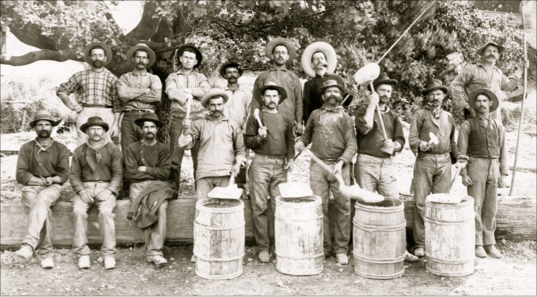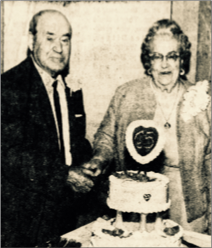During the nearly 100 years in which lime was manufactured commercially in Santa Cruz (late 1840s to 1946), the majority of the lime workers were European immigrants. In the early days, many were Irish; later, Italians and Portuguese predominated. At last fall’s History Fair, several people with family connections to the local lime industry stopped by the Friends of the Cowell Lime Works table. Later, I met with two of them, Santa Cruz residents Ida Tarantino and Jim Bosso. Both had grandfathers who came here around the turn of the last century and worked for the Henry Cowell Lime and Cement Company. Both came from the same part of Italy, but their family stories are different in many ways.
Agostino Puccinelli
Ida Tarantino’s grandfather, Agostino Puccinelli, was born October 18, 1871, in Montecarlo, a town in Tuscany not far from Florence and Pisa. As a young man he studied to be a priest, but changed his mind and instead emigrated to the United States in about 1896. Ida says life was very hard in Italy and there were few jobs. He first lived in Chicago, and it was there that he became a naturalized U.S. citizen.
By 1900, according to census records, he was living in Santa Cruz. He worked for Cowell for only a few years. In a group photo of Cowell workers, he is posing with other men who are holding tools such as shovels and small hammers, and there are four lime barrels in the foreground. It would seem that he was most likely involved directly with the lime-making process, or perhaps he worked making or loading the barrels of lime for shipping.
After he left his job with Cowell he worked at the Kron Tannery (later known as the Salz Tannery and now the Tannery Arts Center). In June, 1905, he married Ida Meschi, another Italian immigrant, still in her teens. She was from Lucca, also in Tuscany. In those days you had to have a sponsor to settle in America, and Ida was sponsored by her uncle, who also lived in Santa Cruz. She worked as a maid in the Kron household.
While he was still working at the tan-nery, the couple purch-ased a dairy cow, then another, and so on, until pretty soon he quit his job with the tannery and became a full-time dairyman. The Santa Cruz Dairy eventually had hun-dreds of cows and was located on Encinal Street near where Costco is today. They also had dairy cattle on the coast just north of Santa Cruz.
They milked twice a day and sold raw milk. They mostly had Holsteins, which were known for the great quantity of milk they produced. They also had some Jerseys, which produced milk with a higher fat content. The milk sold by Santa Cruz Dairy was a blend of the two.
Agostino Puccinelli retired from the diary business in 1947 and died in Santa Cruz three years later at age 79. His wife, Ida, died in 1962 at age 74.
Angelo Seghetti
Angelo Seghetti was born in 1882 in Lucca, Tuscany, and began working for Cowell near the turn of the century.
According to his grandson, Jim Bosso, Angelo made the journey from Italy in the steerage section of a ship. He arrived in New York with $38, just enough for the train fare to Santa Cruz. Jim is not sure how he came to work for Cowell, but it was his first place of employment here. He worked for several years, saving his money, before sending for his wife, Concetta, and son Ardito.
Angelo Seghetti lived to age 90, so Jim got to know his grandfather well and remembers many of the family stories. Jim said that as you go into the main entrance at UCSC, the Portuguese cottages were on the right and the Italian cottages were on the left. There were two men per cabin, and they had double beds.
When his grandfather worked there in the very early 1900s, payday was still just once a year—on Christmas. Angelo earned $1.50 per day, which was more than most of the other workers because he spent extra time grooming and feeding the animals such as the horses and mules. Although such pay was low even for those days, the workers were supplied everything they needed, including room, board, and a store to buy supplies. The men turned in their clothing once a week to be washed and exchanged for a clean pair. Concetta worked for a while doing the washing, for which she earned 50¢ per day.
Angelo used to drive the team of horses pulling a wagon full of rock from the quarry down the road to the then-new lime kilns at Rincon. At the kilns, the rock was cooked until it converted to lime. The road was fine in the summer, but it could get real slippery after winter rains. Once in a while the wagon would start to slide off the road, and Angelo would have to whip the team to recover.
Many if not all of the Italian and Portuguese lime workers went by nicknames. Back in Italy, Angelo had been a drummer in an army band, and continued as a drummer in the Cowell band. So, his nickname was “Tombalino” (drummer in Italian) according to the family.
After Concetta and Ardito arrived, the couple had three more children, all girls. Angelo left Cowell sometime in the 1910s and worked as a farmer on the North Coast. Later, he ran a hotel and restaurant near the south end of Pacific Avenue.
The family kept many cultural traditions from Italy, especially the food. Jim remembers going to big family gatherings at his grandparents’ home on River Street. On holidays like Christmas and Thanksgiving they would have a traditional Italian meal first, then, after a few hours rest, have the American version with turkey, etc. Everything was homemade, with the host doing most of the cooking. While the women prepared dinner, the men would play cards.
Angelo had his own wine barrel and would make wine from grapes brought by friends from Madera and Stockton. They would stomp the grapes with their boots on.
Angelo and the other Italians also liked hard liqueur and would make their own brandy. Jim says his grandfather had a shot of brandy with two raw eggs every morning at breakfast. He also enjoyed small Italian cigars made of a single tobacco leaf rolled up and soaked in brandy. As mentioned previously, Angelo lived to age 90.
In searching through old newspapers, trying to learn more about Angelo and Concetta, I was surprised to discover that the two did not become U.S. citizens until June of 1943. By then, she was 58 and he was 61. They were part of what was, at that time, the largest class of citizenship applicants ever to appear before the Santa Cruz County Superior Court—140 in all. Of the first group of 41, 31 were Italian. Of course, the United States was at war with Italy at that time.
Not surprisingly, the stories of Agostino Puccinelli and Angelo Seghetti have some similarities, but also many differences. Both were immigrants from the same part of Italy and both worked for Cowell for just a few years. They came from different backgrounds with different skills and interests. Agostino married in Santa Cruz, while Angelo married in Italy. Both belonged to the United Ancient Order of Druids and various Italian clubs and both resided in the same Santa Cruz neighborhood. Both seem to have adapted well to their adopted country, and were successful in work and raising a family.
The story of the Cowell lime workers is a vast, sweeping tapestry encompassing many decades and hundreds of people. By collecting stories from multiple families, we get a more accurate overall picture of these people and their important contributions to local history. We are grateful Ida Tarantino, Jim Bosso, and Jim’s extended family for sharing the stories of their grandfathers and thereby coloring in a few more pieces of the lime-worker picture.




